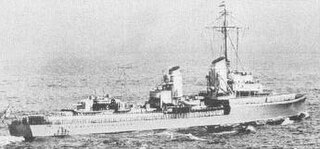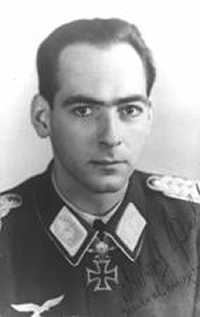
Wolfram Karl Ludwig Moritz Hermann Freiherr von Richthofen was a German World War I flying ace who rose to the rank of Generalfeldmarschall in the Luftwaffe during World War II.

Kurt Arthur Benno Student was a German general in the Luftwaffe during World War II. An early pioneer of airborne forces, Student was in overall command of developing a paratrooper force to be known as the Fallschirmjäger, and as the most senior member of the Fallschirmjäger, commanded it throughout the war. Student led the first major airborne attack in history, the Battle for The Hague, in May 1940. He also commanded the Fallschirmjäger in its last major airborne operation, the invasion of Crete in May 1941. The operation was a success despite German losses, and led the Allies to hasten the training and development of their own airborne units.
Fliegerführer Afrika was part of Luftflotte 2, one of the primary divisions of the German Luftwaffe in the Second World War. It operated in the Mediterranean and Libya from 1941–1942. The commanders were Generalmajor Stefan Fröhlich and Generalleutnant Otto Hoffmann von Waldau, who led the German air support to the German Afrika Korps campaign during the winter of 1941–1942.

Operation Wikinger was a German naval sortie into the North Sea by six destroyers of the Kriegsmarine on 22 February 1940 during the Second World War. Poor inter-service communication and co-operation between the Kriegsmarine and the Luftwaffe resulted in the loss of two German warships through friendly fire bombing and German or British mines. Only sixty survivors were rescued and the operation was called off.

Dietrich Peltz was a German World War II Luftwaffe bomber pilot and youngest general of the Wehrmacht. As a pilot he flew approximately 320 combat missions, including roughly 130 as a bomber pilot on the Eastern Front, 90 as a bomber pilot on the Western Front, and 102 as a dive bomber pilot during the invasion of Poland and Battle of France.

Luftflotte 1 was one of the primary divisions of the German Luftwaffe in World War II. It was formed 1 February 1939 from Luftwaffengruppenkommando 1 in Berlin. This Luftwaffe detachment served in Estonia, Latvia, Lithuania and Immola, Finland, for air support of Axis forces in area; with command offices in Malpils, Latvia,, Eastern front.

Hermann Hogeback was a German bomber pilot during the Nazi era. He flew more than 100 operational sorties during the Spanish Civil War and 500 during World War II and was a recipient of the Knight's Cross of the Iron Cross with Oak Leaves and Swords of Nazi Germany. Hogeback's last service position was commander of the 6th Bomber Wing.
Martin Fiebig was a German Luftwaffe general who commanded several air corps and equivalent-sized formations during World War II. He was a recipient of the Knight's Cross of the Iron Cross with Oak Leaves.

Martin Harlinghausen was a German military aviator and general. Harlinghausen specialised in maritime interdiction and anti-warship operations. During World War II Harlinghausen was the leading exponent of anti-ship warfare with the destruction of 22 ships credited to him.

Kampfgeschwader 76 was a Luftwaffe bomber Group during World War II. It was one of the few bomber groups that operated throughout the war.
2nd Air Corps was formed on 11 October 1939 in Frankfurt am Main from the 2. Flieger-Division. During Operation Barbarossa and from 22 June to 12 November 1941, the Corps flew over 40,000 day and night sorties, dropping 23,150 tons of bombs and claiming 3,826 Soviet aircraft destroyed as well as 789 tanks, 614 artillery pieces, 14,339 vehicles, 240 enemy field positions, 33 bunkers, 159 trains and 304 locomotives along with relentless attacks on enemy troop concentrations and logistical choke-points.
I. Fliegerkorps was formed 11 October 1939 in Cologne from the 1st Air Division. The Corps was also known as Luftwaffenkommando Don between 26 August 1942 until 17 February 1943. It was transformed to the 18th Air Division on 4 April 1945.

IV. Fliegerkorps was formed 11 October 1939 in Düsseldorf from the 4. Flieger-Division. The Corps was disbanded on 16 September 1944 and its Stab formed the Kommandierenden General der Deutschen Luftwaffe in Dänemark.

Fliegerführer Atlantik was a World War II Luftwaffe naval air command dedicated to anti-maritime transport, anti-submarine, anti-surface enemy fleet, close air support Kriegsmarine for operations in the Atlantic Ocean, maritime interdiction, and maritime reconnaissance. The air command fought exclusively in the Battle of the Atlantic.

Kampfgeschwader 26 "Löwengeschwader" was a German air force Luftwaffe bomber wing unit during World War II. Its units participated on all of the fronts in the European Theatre until the end of the war. It operated three of the major German aircraft medium bomber types; the Heinkel He 111, Junkers Ju 88 and the Junkers Ju 188. The unit engaged in both strategic bombing, close air support, anti-shipping and aerial interdiction operations. The majority of its operational life – not entirely unlike another Luftwaffe wing designated KG 40 — was spent on anti-shipping missions.
IX. Fliegerkorps was formed in November 1940 in Jever from the 9. Flieger-Division and was redesignated as IX. Fliegerkorps (J)—the suffix "J" stands for Jagd —on 13 November 1944. The Corps at the time was leading numerous Kampfgeschwader which were converting to fighter aircraft. The Corps was renamed again on 26 January 1945, this time to IX. (J) Fliegerkorps.

Hans-Ferdinand Geisler was a German general during World War II.

Kampfgeschwader 30 was a Luftwaffe bomber wing during World War II.

Kampfgeschwader 1 was a German medium bomber wing that operated in the Luftwaffe during World War II.

Werner Kreipe was a German World War II Luftwaffe General der Flieger.















